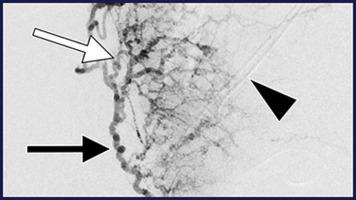Journal of Vascular and Interventional Radiology ( IF 2.9 ) Pub Date : 2022-09-24 , DOI: 10.1016/j.jvir.2022.09.018 Shinya Kosai 1 , Hiroki Higashihara 2 , Hiroki Yano 1 , Eiji Kashiwagi 1 , Keisuke Nagai 3 , Kaishu Tanaka 1 , Yusuke Ono 1 , Tatsuya Miyake 4 , Noriyuki Tomiyama 1

|
Purpose
To identify risk factors for clinical failure of uterine artery embolization (UAE) for postpartum hemorrhage (PPH), with particular attention to the uterine artery diameter.
Materials and Methods
This retrospective study included 47 patients who underwent UAE for PPH between January 1, 2010, and January 31, 2021. Technical success was defined as the completion of embolization of the arteries thought to be the cause of the bleeding. Clinical success was defined as no recurrent bleeding or need for additional therapeutic interventions. Univariate and multivariate analyses were performed to examine the risk factors associated with clinical failure of UAE.
Results
Of the 47 patients, 6 had recurrent bleeding. Of the 6 patients, 4 underwent hysterectomy, and 2 underwent repeat embolization. The clinical success rate was 87.2% (41/47), with no major adverse events such as uterine infarction or death. In univariate analysis, there were slight differences in multiparity (P = .115) and placental abruption (P = .128) and a significant difference in the findings of a narrow uterine artery on digital subtraction angiography (DSA) (P = .005). In multivariate analysis, only a narrow uterine artery on DSA was a significant factor (odds ratio, 18.5; 95% confidence interval, 2.5–134.8; P = .004).
Conclusions
A narrow uterine artery on DSA was a risk factor for clinically unsuccessful UAE for PPH. It may be prudent to conclude the procedure only after it is ensured that vasospasm has been relieved.
中文翻译:

子宫动脉栓塞治疗产后出血临床失败的相关危险因素
目的
确定子宫动脉栓塞术 (UAE) 治疗产后出血 (PPH) 临床失败的危险因素,尤其要注意子宫动脉直径。
材料和方法
这项回顾性研究包括 47 名在 2010 年 1 月 1 日至 2021 年 1 月 31 日期间接受 UAE 治疗 PPH 的患者。技术成功的定义是完成被认为是出血原因的动脉栓塞。临床成功被定义为没有复发性出血或需要额外的治疗干预。进行单变量和多变量分析以检查与 UAE 临床失败相关的危险因素。
结果
47 例患者中有 6 例有反复出血。6 例患者中,4 例接受了子宫切除术,2 例接受了再次栓塞。临床成功率为87.2%(41/47),无子宫梗死或死亡等重大不良事件发生。在单变量分析中,多胎次 ( P = .115) 和胎盘早剥 ( P = .128)存在细微差异 ,数字减影血管造影 (DSA) 狭窄子宫动脉的发现存在显着差异 ( P = .005) . 在多变量分析中,DSA 显示只有狭窄的子宫动脉是一个重要因素(比值比,18.5;95% 置信区间,2.5–134.8;P = .004)。
结论
DSA 显示子宫动脉狭窄是 UAE 治疗 PPH 临床不成功的一个危险因素。只有在确保血管痉挛得到缓解后才结束手术可能是谨慎的做法。

























 京公网安备 11010802027423号
京公网安备 11010802027423号